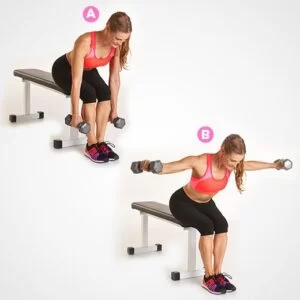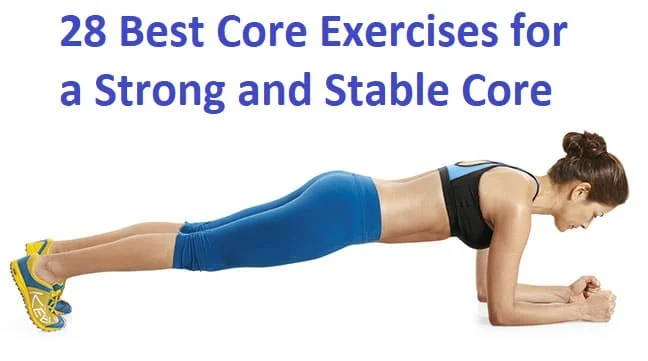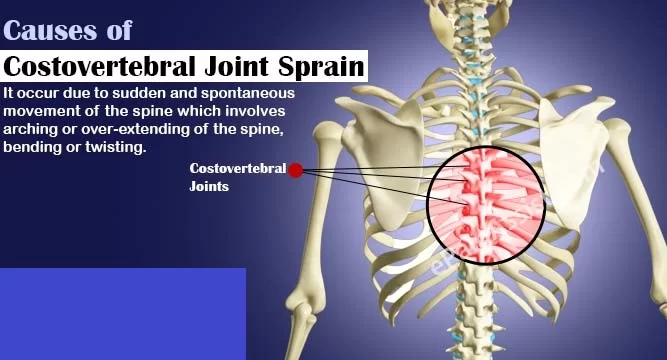14 Best Chair Exercises
Introduction
Chair exercises are a great option for people who are getting better from an injury or have balance or mobility concerns since they allow you to engage your lower body while seated or supported. They’re also excellent for expectant mothers who want a little additional help as their tummy expands.
However, working your legs isn’t the only thing you can do. You may also engage your arms, shoulders, and chest in addition to the vital core muscles that aid with stabilization. Additionally, a chair is the ideal partner for Pilates chair exercises and sat stretches. You may thus benefit greatly from these exercises whether you are sitting on a chair or are just holding onto one for support.
A chair can be useful for everyone, but it’s usually best suited for those who require help or who struggle to get up and down from the floor. In order to be fit, we must learn to trust our bodies, and using a chair or other safety net can help us develop that confidence.
This is particularly true for learners who might want that safety net as they learn to trust their bodies via movement. According to Summers, chair workouts also allow you to concentrate on the actions themselves rather than your equilibrium. Both novices and more experienced exercisers trying to learn progressions can benefit from this.
There are a tonne of chair workouts you can perform; some are chair-specific, while others are just variants of well-known movements you’ve probably done before. We’ve included our favorites here. But before we go into our top choices, let’s talk about the basics of chair workouts, their efficacy, and why chair use is advantageous for almost everyone in need of a good, full-body workout.
What is the effectiveness of Chair Exercises?
Chair exercises may be quite effective when performed correctly and help you train every muscle in your body. Simple maths is the secret to a successful chair workout: Include exercises that hit as many muscle groups as you can while maintaining your ability to sit (if necessary) or using the chair as part of the workout or for balance.
any of them function in the same manner as techniques you’re already acquainted with, which is one of the reasons they’re so powerful. For example, do a plank or push-up with your hands up on the seat. You’re still engaging in the same fundamental activity even if the chair tilts your body, which helps relieve some of the weight.
The use of a chair alters the angle at which the exercise is performed and how you will complete it, but it does not modify the movement’s goal. That implies that while a plank from a chair will still engage your complete core, a push-up from a chair will still train your shoulders, triceps, and chest muscles. So chair exercises can assist in providing the core strength training you’re seeking.
Are chair exercises limited to beginners only?
Nope. Chair workouts are great because they can be customized to meet various levels of fitness. Chairs are excellent for increasing your level of fitness since they let you advance and regress movements.
Simple exercises like squats may be made simpler with the use of a chair. It can also enforce stricter form and provide you with a hint (the seat!) on how low to lower your body. According to Summers, a chair provides a tactile indication that enables you to lower yourself without feeling as though you’re falling when practicing the perfect squat technique. It can also be used as a seat if necessary. Having said that, she makes it very evident that there is a significant distinction between just throwing yourself onto the chair and using control when sitting (hint: you should use control).
Chairs are also excellent instruments for mixing in more difficult workouts. Let’s revisit push-ups as an example. A classic push-up is a challenging exercise since you have to do the movement from the floor. However, raising your hands might make it easier to do. Thus, you may start by pushing yourself up on a chair’s seat while keeping your hands raised.
After you’ve gotten the hang of it, you might be able to practice on a surface that is closer to the ground, such as a step or box, rather than doing them directly off the floor. Then, to intensify the exercise even more, you may perform a decline push-up that feels far more difficult than a standard one by placing your hands on the floor and your feet on the chair’s seat.
This also holds true for a pistol squat, in which you lower yourself completely while extending one leg in front of you. This is a very clever move. To help you become accustomed to that movement pattern and develop the single-leg strength required to perform it, try doing a single-leg squat to the chair (see below). In this exercise, you elevate one leg off the ground in front of you and squat down with the planted foot until your butt hits the chair’s seat.
Examples of chair exercises
Seated Oblique Crunch
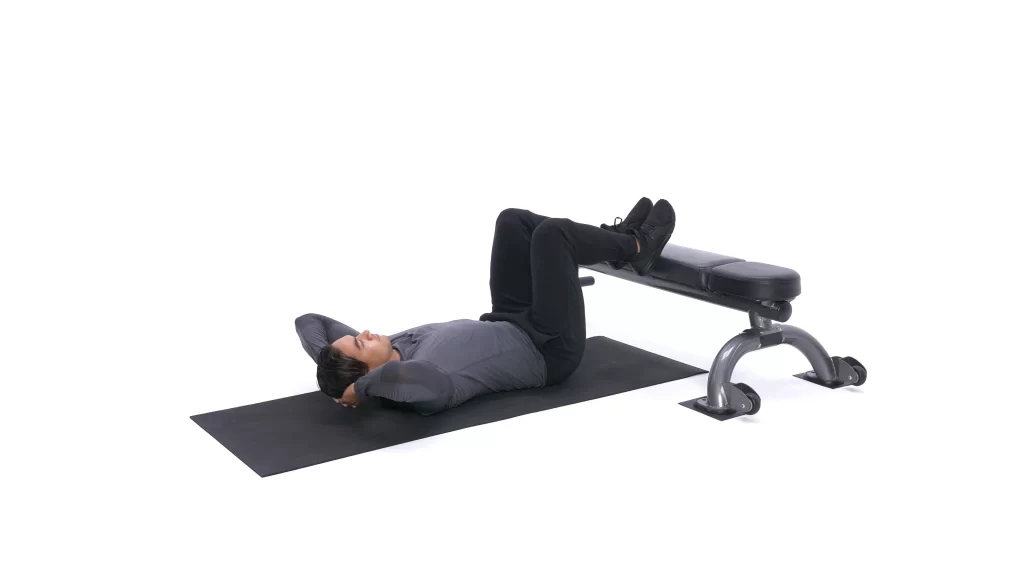
- Position yourself on the chair’s edge, keeping your shoulders shoulder-width apart and your back straight.
- With your elbows pointed out to the sides, place your fingertips behind your head.
- As you crunch to the right, shift your weight to the left leg and raise your right knee to your right elbow.
- Step back to the beginning position by lowering your right leg.
- Turn around and place your left leg at your left elbow. That amounts to one rep.
Incline Mountain Climbers
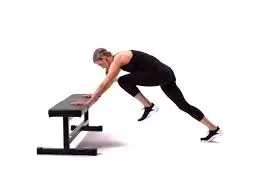
How to put in:
- Put yourself in a plank posture, with your hands shoulder-width apart, your back flat, your abs locked in, and your head aligned. Your palms should be resting on the chair’s seat.
- As soon as you can, bring your right knee up to your chest.
- Make a leg switch by drawing your left knee in and bringing your right knee back. That amounts to one rep.
- Maintain your hips down while you run your knees in and out as quickly and as far as you can.
Seated Lean Backs
How to:
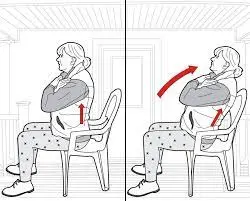
- With your feet level on the floor and a little wider than hip-width apart, take a seat on the edge of your chair. With your palm resting on your shoulders, cross your arms across your chest.
- As you lean back in the chair, make sure your spine stays in the same position.
- You can return to the beginning position once your upper back contacts the rest. That amounts to one rep.
- Pro tip: To feel your core muscles working hard to fight gravity, perform this action slowly.
Seated Alternating Toe Touches
How to:
- With your feet level on the floor and barely wider than shoulder-width apart, sit tall and with a straight spine. Raise both arms over your head, pointing your fingers upward.
- Bring your right foot to meet your left hand halfway down.
- Bring your right foot to meet your left hand halfway down. Your right foot’s inside should be tapped.
- With your left foot and right hand, repeat the movement back to the beginning position. That amounts to one rep.
Seated Cross-Body Punches
How to:
- With your feet level on the floor and spaced slightly wider than your shoulders, take a seat on the edge of your chair.
- Raise both arms to the front of your face and form fists.
- As you turn to your right, keep your left arm out in front of you.
- Bring your left elbow back to where it was at the beginning.
- Using the right arm, repeat the action. That amounts to one rep.
Chair squats
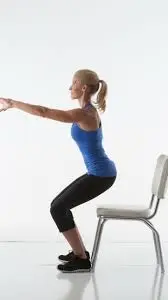
Prepare to provide a significant boost to your lower body with chair squats. This workout strengthens your glutes, hamstrings, and quadriceps while enhancing your stability and balance.
Steps:
- Make sure the chair you’re sitting on is solid and won’t move by sitting on its edge.
- Step with your feet hip-width apart.
- Pushing through your heels, stand up, and then calmly return to a seated position.
- Try to complete three sets of ten to twelve repetitions.
Seated march
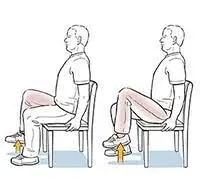
Use the sitting march to increase your cardiovascular endurance at home. This easy-to-do but powerful workout works your leg and core muscles while raising your heart rate.
Actions:
- With your feet flat on the ground, take a lofty stance on your chair.
- Raise one leg to your chest, then bring it back down. Repeat with the other leg.
- For a predetermined amount of time, say one or two minutes, keep switching legs.
Sit-to-stands

Are you prepared to use your legs more powerfully and improve your sitting experience? Then, it’s time to use sit-to-stands to escape the restrictions of your chair. Your buns and your mood will be lifted as you tone that ass and activate your leg muscles!
Actions:
- Position yourself on the chair’s edge, keeping your feet hip-width apart. As you rise up, tighten your glutes, and then slowly return to a seated position.
- Try three sets of ten to twelve sit-to-stands, and don’t forget to maintain proper form!
Heel slides
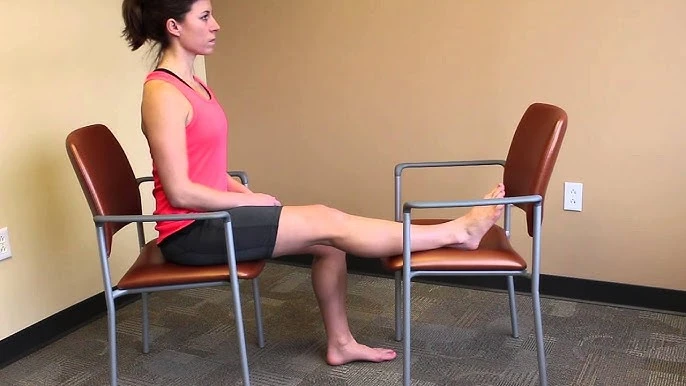
With heel slides, you may achieve new heights of lower-body elegance. Bring out the dancer in you and show off some skills that would make Usher proud. These slides can help you get more flexibility and well-defined legs from the comfort of your chair; they’re not only for dance floors.
Steps:
- Take a lofty seat on your chair and visualize yourself moving across the floor with elegance.
- Maintaining your toes on the ground, move one heel forward and then back.
- Continue with the other heel, showcasing your elegant gait.
- 3 sets of 10–12 heel slides each leg should be the goal.
Seated calf raises
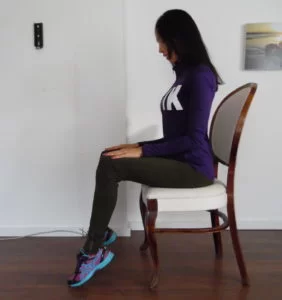
Your lower legs will be pleading for mercy as you fight gravity while sitting up straight on a chair for seated calf raises.
Actions:
- Channeling your inner ballerina, sit proudly on your chair.
- Elevate your heels off the ground to fully display your calf muscles.
- Track your steps, but don’t allow them to lose sight of their amazing strength.
- 3 sets of 10–12 seated calf raises should be the goal.
Modified planks
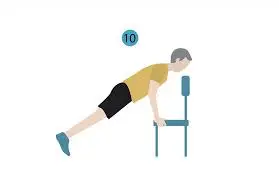
Who says using your core requires being on the ground? Prepare to use customized boards to defy the rules of physics! With this chair-friendly version of the traditional plank, you can work on your core strength, stability, and balance while sitting.
Step:
- Take a seat on a strong chair’s edge.
- Stretch your legs straight out in front of you and place your hands on the chair seat with your fingers pointing forward.
- Pull your belly button in towards your spine while keeping your body in a solid posture to activate your core muscles.
- Aim to maintain a straight posture from head to heels, with no undue arching or drooping of the lower back.
- For a certain amount of time—for example, thirty seconds—hold this posture while paying attention to your form and using your core the entire time.
- As your core strength increases, progressively increase the time of each set of three-sitting modified planks.
Seated shoulder press
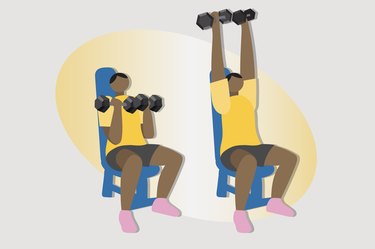
With sitting shoulder presses, you may push the boundaries of your shoulder strength. By using your deltoid muscles, this exercise will help you develop strong, well-defined shoulders.
Actions:
- Prop your back straight, feet level on the ground, and sit tall.
- With your hands facing front, hold a pair of low-weight dumbbells or other appropriate weights at shoulder height.
- While completely extending your arms without locking your elbows, press the weights directly overhead.
- Return the weights to shoulder height gradually.
- Try to complete three sets of ten to twelve seated shoulder presses; as your strength increases, progressively increase the weight.
Seated front shoulder raises
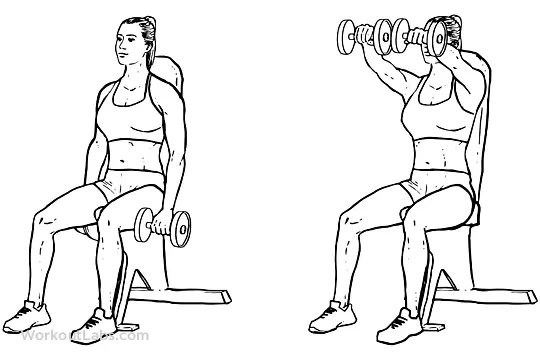
Seated front shoulder raises, target the front of your shoulders, strengthen your upper body, and help you develop a gorgeously contoured torso. At last, you’ll feel confident enough to wear those sleeveless tops!
Actions:
- Maintaining proper posture and using your core, sit tall in your chair.
- With your arms by your sides, grasp a pair of dumbbells or other appropriate weights in your hands.
- Lift the weights in front of you until they reach shoulder height while maintaining a straight arm position.
- Return the weights to your starting position gradually.
- Try to complete three sets of ten to twelve sitting front shoulder lifts, feeling your front delts burn as you complete each rep.
Modified push-ups

Modified push-ups are a great way to include conventional push-ups into your chair training program. This chair-friendly version of the well-known bodyweight workout addresses your triceps, shoulders, and chest.
Actions:
- With your hands slightly broader than your shoulders, lay them on the edge of your chair facing you.
- Make a diagonal line with your feet as you walk back from your head to your heels.
- Keeping your torso in a straight line, bend your elbows and drop your chest towards the chair.
- Reach out with your arms and push through your palms to go back to the beginning position.
- Try to complete three sets of ten to twelve modified push-ups, progressively getting harder by lowering the chair or shifting your feet further back.
Safety Considerations
Chair exercises don’t require a specific chair, but the one you use should be supportive. Use of a foldable chair or one with rollers or wheels is not advised. Armless chairs are ideal for most workouts. To prevent your chair from slipping, you might need to back it up against a wall if it is positioned on a smooth surface.
If you are not feeling well, avoid exercising. If you have nausea, dizziness, chest discomfort, balance issues, or difficulty breathing during exercise, consult your doctor. You could have worked out too hard if you woke up the next day with excruciatingly aching muscles.
Conclusion
Who says working out requires expensive gear and a gym membership? Chair exercises demonstrate that you don’t need any extra luxuries to keep active, gain strength, and have a great time.
Each exercise stimulates a different muscle region, leaving you feeling strong and flexible. Examples of these exercises include stomach twists that spark your core and shoulder presses that shape your deltoids. The fact that every one may take part is the best part.
You can intensify your workouts when you have a chair by your side as a useful fitness partner. Thus, pull up a chair, throw off the monotony, and transform dull times into very productive chances for development, vigour, and a happier, healthier way of life. Next, prepare to chair-ish the benefits from the chair!
FAQs
Do chair exercises really work?
Chair exercises are a fantastic low-impact approach to add movement to your routine, whether you do them in a class setting, from the comfort of your home, or from your workplace. In a 32-minute workout, the majority of people can burn between 120 and 250 calories; this amount of calories can be increased by using weights or resistance bands.
What kind of chair is best for chair exercise?
Chair exercises don’t require a specific chair, but the one you use should be supportive. Use of a foldable chair or one with rollers or wheels is not advised. Armless chairs are ideal for most workouts. To prevent your chair from slipping, you might need to back it up against a wall if it is positioned on a smooth surface.
Can I lose weight with chair exercises?
The good news is that chair workouts can aid in weight loss—especially if you want to maintain your health over 50. Other advantages of including these low-impact workouts in your regular regimen include stronger muscles, more mobility, and better balance.
What kind of chair is healthiest?
An excellent option for a health-conscious desk chair is the saddle stool. Because it has no back, this kind of chair promotes more muscular activation. By rotating your pelvis forward, the saddle configuration preserves the natural lumbar curvature of your spine. The only ergonomic desk chairs that are designed to avoid slouching are saddle stools on wheels.
What are the benefits of chair-based exercise?
Chair-Based Workout
Advantages of Chair-Based Exercise: Enhanced strength and flexibility.
improved coordination
Enhanced blood flow.
decreased risk of falls as a result of chair-based activities that enhance balance and posture.
References
13 Chair Exercises That Work Your Whole Body. Greatist. https://greatist.com/fitness/chair-exercises#Takeaway
20 Chair Exercises to Strengthen and Cardiourelate Your Entire Body. Women’s Health. https://www.womenshealthmag.com/fitness/g41252448/best-chair-exercises/
Best Chair Exercises for Seniors. WebMD. https://www.webmd.com/fitness-exercise/best-chair-exercises-for-seniors

